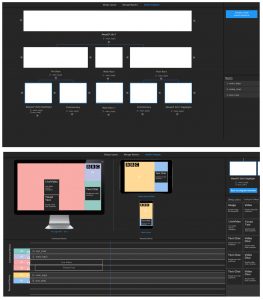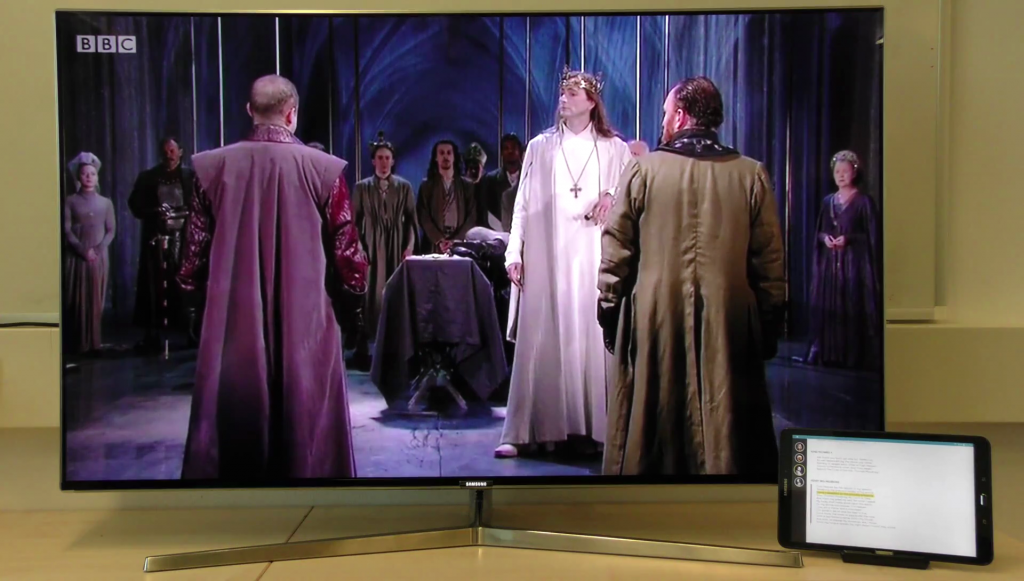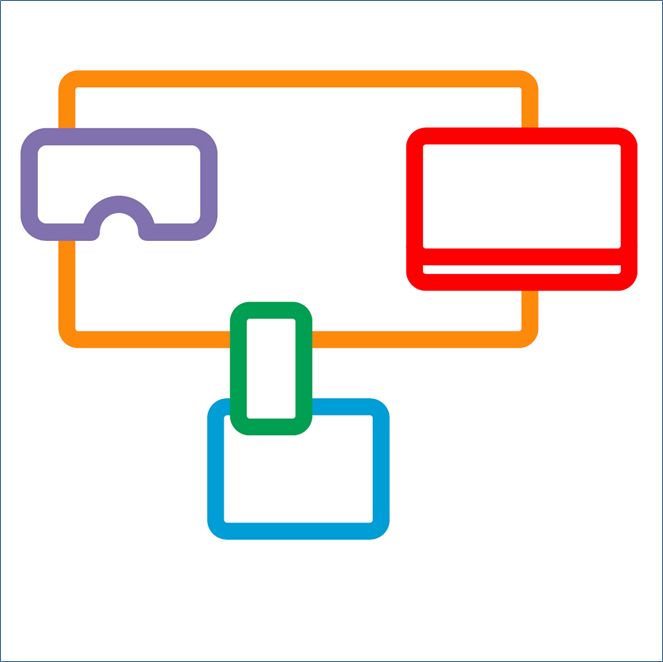Fine-tuning the live production tools
JI LIE of the Distributed and Interactive Systems (DIS) group at CWI Amsterdam writes about the project’s recent encounters with broadcast professionals.
2-IMMERSE is developing a production platform for creating multiscreen and immersive experiences by TV professionals. The production platform includes three software components:
- A preproduction tool that aims at digitalizing the authoring process in an object-based manner. It is a graphical tool to help producers scripting by temporally arranging different media objects (such as video clips, graphics, audio, and subtitles) for both TV screens and companions.
- A live editing tool that enables the production team to react to live events happening during a television program, such as a goal during a football match and an overtake during a MotoGP race. When live events happen, the editorial team can quickly, according to the director’s instructions, edit associated media (graphics, name tags, replay clips) based on prepared templates.
- A live triggering tool that includes a button-based graphical interface and a keyboard launcher. The edited templates are enqueued as a thumbnail on the interface of the launcher, which can then by easily triggered by the director.
The live editing and triggering tools have been successfully evaluated at the Wembley Stadium during the FA Cup semi-final and final and showcased at the International Broadcasting Convention (IBC) 2018 in Amsterdam. The team is now busy further developing the preproduction tool.

Fig. 1. A demo of the live editing tool and the live triggering tool at IBC2018
The initial wireframes of the preproduction tool were designed and iterated based on the inputs of two rounds of interviews with a total of 20 professionals in the broadcasting industry (see papers: “Designing an Object-based Preproduction Tool for Multiscreen TV Viewing” and “A New Production Platform for Authoring Object-based Multiscreen TV Viewing Experiences”). In September of 2018, a number of extra interviews to fine-tune the interface and interaction design of the tool have taken place.

The interviews were conducted with seven professionals (P1-P7; 5 males, 2 females; M=35.0, SD=6.0), whose backgrounds are summarized in Table 1. The interviews happened from 3 – 5 September 2018 at the usability lab of BBC R&D, located in the MediaCity, Manchester.

Fig. 2 (Top). The hierarchical organization of the program chapters; (Bottom) The spacial and temporal arrangements of the DMApp components.
The interviewees confirmed the basic design decisions for the preproduction tool: hierarchical organization of the program sections and sequential arrangements of the media objects following the script (see Fig. 2). The former offers a clear structure and enables the use of a master layout to reduce repetitive production work. The media objects can be configured and reused to have interactive and novel functions on TV programs. These can, for example, enable users to select different view angles or to follow their favourite football players.
In addition, the professionals recommended a node structure to link media objects within a section, to have a clear overview of objects that are running in parallel and those running in sequence. Regarding the layout of the TV program, the professionals confirmed the intuition of the research team that the preproduction tool does not require to manage it.
Based on the feedback, the original interaction design of the tool will be improved, a new development process will take place, and a final evaluation with the seven professionals will happen by the end of November. The idea is to ask the professionals to create a multiscreen and interactive TV sports program. Stay tuned!
READ MOREMotoGP roars out on a HbbTV 2 television
MICHAEL PROBST from the 2-IMMERSE partner IRT introduces an impressive video showcasing our MotoGP prototype running on a HbbTV 2 television.
The 2-IMMERSE architecture has been built around the HbbTV 2 specification, mainly using the new protocols defined for interaction and media synchronisation with multiple screens in the home network.
During the services trials, the project has made use of custom prototype units as client devices. For the most recent trials a Intel NUC-based Linux PC was used to emulate the main TV and feed the screen in the home.
In a parallel track, however, the 2-IMMERSE implementation of the MotoGP trial has been tested and validated with televisions supporting HbbTV2 that became available in 2018. Watch the video, hosted by IRT’s Florian Bachmann, to see the MotoGP showcase on one of the first HbbTV 2 televisions and learn more about which features 2-IMMERSE actually uses from HbbTV 2.
You can see this demonstration at IFA in Berlin (31 August – 5 September) and IBC2018 in Amsterdam (14-18 September) at the IRT stands (hall 2.2@IFA, 10F51@IBC) in addition to the 2-IMMERSE main presentation in the IBC Future Zone.
READ MOREHbbTV 2: a note on the state of play
MICHAEL PROBST from IRT writes:
Hybrid Broadcast Broadband TV (HbbTV), as Wikipedia details, is both an industry standard (ETSI TS 102 796[1]) and promotional initiative for hybrid digital TV to harmonise the broadcast, IPTV, and broadband delivery of entertainment to the end consumer through connected TVs (smart TVs) and set-top boxes.
The latest release of the HbbTV specification was released about a year and a half ago. From a public perspective, not much has happened since then, as it is still not possible to purchase a HbbTV 2-enabled TV. But in fact, a great deal has been happening “behind the curtains” and HbbTV 2 is evolving steadily. In this post we highlight some of the latest developments in terms of implementations and services.
Let’s have a short look at the new elements in HbbTV 2:
- Support for HTML5 including the Media Elements replacing the “unloved” XHTML 1.0
- Fancy UIs with CSS3 Animations and Transitions, but also downloadable fonts, e.g. to support languages with exotic characters.
- Enabling closed subtitles for all broadband delivered media.
- Companion screen: discovery of TVs and launching HbbTV apps; discovery of special (manufacturer specific) launcher apps and launch of mobile apps; communication between HbbTV apps and mobile apps
- Media Synchronisation: The most complex feature allows to play broadcast on TV with content from the Internet in sync either also on TV or on the companion device.
HbbTV 1.5 was a relatively small update to the first release and included only features with urgent market needs, and hence it was implemented and deployed rather quickly. In Germany we can assume that all new TVs sold in 2017 implement 1.5. The market share of these devices, in relation to all HbbTV TVs, depends to a degree on who you ask, but now in summer 2017 it is quite likely 50%.
Once HbbTV 2 is deployed Germany’s broadcasters will have to deal with a large legacy of HbbTV 1.X devices. Other countries have the advantage of starting with HbbTV 2 but will have to migrate from former platforms like MHEG-5 (UK) and DVB-MHP (Italy). The UK industry has chosen to launch HbbTV with a sub-profile (Freeview Play), that does not include companion screen and media sync features, but Italy could be the first country where deployed TVs have a full HbbTV 2 implementation.
The HbbTV consortium is still very active and working on a number of different topics to allow HbbTV to find new markets:
- The test suite already supports a first set of the HbbTV 2 test cases, and the HbbTV testing group is working hard to complete it.
- ADB (Application discovery via broadband) is a specification that will make HbbTV services available in broadcast networks where operators block or do not care about HbbTV. A second version of this spec will allow scenarios were people to have to use STBs of the network operator, e.g. by employing watermarks.
- IPTV: this spec addresses specific issues to use HbbTV in IPTV networks, i.e. where they differ from classical broadcast networks
- Operator apps: not yet released, but this specification will define a complete new class of applications suitable for broadcast network operators.
HbbTV 2 in action

Synchronised textbook using HbbTV 2; image shows the Royal Shakespeare Company production of Richard II (2013), © RSC.
Several companies have shown prototypes over the last years including the BBC and IRT who are partners in the 2-IMMERSE project.
In 2015 IRT presented a first HbbTV 2 showcase – live streaming of MPEG DASH with EBU-TT-D subtitles – with several partners including both manufacturers of streaming encoders and TVs, as well as a CDN provider and content provider. As a result of the success of this activity we now see first live streaming services with MPEG-DASH and subtitles offered by ARD broadcasters. More information on this can be found here.
Also in 2015 IRT cooperated with ARD Mediathek – a service providing catch-up TV – to enable their mobile application to cast videos on HbbTV 2 TVs. The application has been very useful for testing HbbTV 2.0 features for automatic discovery and application launch with a large number of TV manufacturers and the next step will be that the function is integrated into the end-user version of the application. Further information here.
The concept of HbbTV 2 Media Synchronisation is largely based on contributions from the BBC. TNO and IRT also supported it as part of their cooperation in the EU-funded hbb-next project. The BBC have done some early HbbTV 2 implementations using their own TV emulator and have released libraries and tools as open source on github.com. At TV Connect 2017 they showcased synchronised playback of broadband media on the companion device with a broadcast service on TV in cooperation with Opera TV.
If you have not had the chance to see any of these demos, there is another one at IFA Berlin and IBC Amsterdam, both taking place in September.
The HbbTV 2 demos of IRT this year will focus on media synchronisation for broadcast services, like broadband delivered foreign language audio tracks. As a study for new types of devices emerging, IRT has implemented a companion application for Microsoft’s Hololens, that will show additional synchronised video feeds alongside the real picture of an HbbTV 2 TV set.
At the IFA IRT demos can be seen at the booth of ARD digital in hall 2.2/103 (look for the IRT table at the back of the booth). And at IBC IRT’s stand is in hall 10.F51 (in a corner of hall 10). We look forward to seeing you there.
READ MORE

